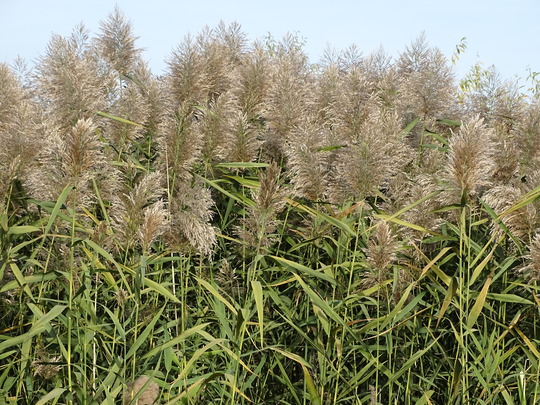|
Having trouble viewing this email? View it as a Web page.
August 2, 2023
August Weed of the Month: Non-native Phragmites
The non-native Phragmites control program is in full swing, and you can help!
Julia Bohnen, University of Minnesota, Department of Fisheries, Wildlife, and Conservation Biology
Non-native Phragmites (Phragmites australis subsp. australis) is a tall wetland grass, reaching up to 18 feet tall and surpassing even invasive cattails in height. It grows very densely, crowding out other species by its sheer presence. It thrives in wet to damp soil conditions, growing in roadside ditches, stormwater ponds, agricultural drainageways, lakeshores, and wetlands.
In Minnesota, non-native Phragmites began receiving attention in 2017 when funding was obtained to document its distribution in the state. After two years of an intensive crowd-sourcing effort, researchers in Minnesota determined that the state could likely avoid the large impactful invasions that have decimated native biodiversity and resulted in costly management efforts in parts of neighboring states, if action was taken immediately.
Minnesota is home to native Phragmites (Phragmites australis subsp. americanus), which can be somewhat tricky to distinguish from non-native Phragmites. Both are tall and can occur in large clones, but native Phragmites tends to grow less densely, and wetlands with native Phragmites typically host many other native wetland plants. Learn how to distinguish non-native Phragmites from native Phragmites using this identification guide.
 Despite its rather attractive floral display, invasive Phragmites should be controlled due to its propensity to take over wetland habitats. Photo by Julia Bohnen
Click here to download the photo.
Non-native Phragmites, like its native counterpart, is a perennial that expands clonally by rhizomes (below-ground horizontal stems) and stolons (above-ground horizontal runners). Construction activities can cause the spread of these propagating parts. Non-native Phragmites also readily propagates from stem cuttings. This means of propagation is likely underestimated as a source of spread. Where it occurs along roadways, this tall grass is typically mowed during the growing season to maintain highway sightlines for safety. Fragments of green stems, moved along the roadway and dropped in a wet spot, can generate roots and shoots in about five weeks, starting a new population and exacerbating the maintenance problem.
Dispersal via wind-blown seed is also an important means of spread. Seed develops in late October-early November and is likely blown across the frozen, snow-covered landscape throughout much of the winter. Likewise, mowing after seed development can disperse the seed to non-infested locations where new populations may establish.
Non-native Phragmites has several ecological and economic consequences. It produces significantly more biomass than native Phragmites; this excess biomass alters the environment. Wetlands fill in at a faster rate and breeding habitat at the shallow edges of wetlands and lakes is diminished for amphibians, fish, and birds. Recreational access to lakeshores and wetlands can be obstructed by these reeds. Stormwater ponds and agricultural ditches fill in faster than designed, causing flooding and increased maintenance costs. Non-native Phragmites causes costly impacts to roadways where the invasive grows into road rights-of-way.
The current distribution of non-native Phragmites is somewhat uneven, with scattered populations in several outstate counties and a heavier concentration of populations in the 13-county metropolitan area. Non-native Phragmites is a Prohibited Control Noxious Weed, and funding from the Great Lakes Restoration Initiative is currently being used to eradicate the outstate populations before they spread further while simultaneously working on control in areas where it occurs more densely. Treatment with herbicides in late summer or fall is the primary way to effectively control it.
Efforts are also being made to increase awareness of this relatively new invasive and encourage reporting of undocumented populations so they can be targeted for treatment. Professionals and the public are encouraged to learn to recognize non-native Phragmites, to report it and to take actions to prevent further spread. If you find non-native Phragmites, please report it to EDDMapS or the Minnesota Department of Agriculture Report a Pest.
MEDIA: For more information on Weed of the Month, contact Brittany Raveill, MDA Communications, at brittany.raveill@state.mn.us or 651-201-6131
|